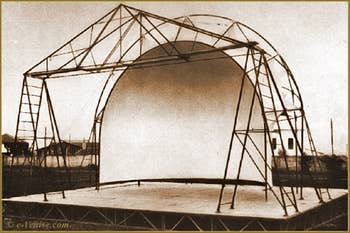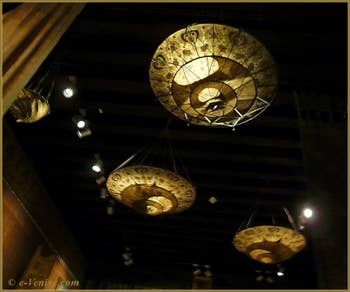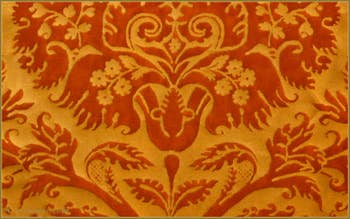Art Painters | Music | Literature | Video | Pictures
Painters Tintoretto | Titian | Canaletto | Fortuny | Albrecht Dürer |
Fortuny Museum Fortuny | Martinengo Orfei | Theatre | Clothes Fabrics | Photography Costume
Mariano Fortuny and his mother founded the first Mariano Fortuny company in Venice in 1911
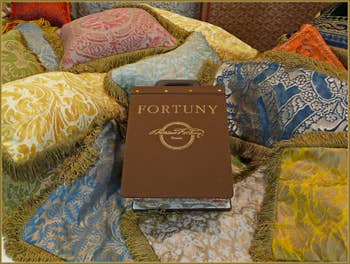
Fabrics Mariano Fortuny After the triumph of his products at the Arts Déco exhibition in Paris, Mariano and his mother Cecilia founded the Société Mariano Fortuny in December 1911, whose registered office was at the palais Martinengo (calle del Traghetto in San Gregorio, no. 178), and whose share capital amounted to ten thousand lire, invested in equal shares.
The purpose of the company was to promote “manifestations of pure and applied art” and Mariano made available “technical and artistic systems and processes” of his speciality, i.e. all his creations and inventions that he had patented.
A flourishing business and shops in Paris, London, Madrid, then New York
The success and influx of numerous orders had led to the expansion of the workshop in the palazzo Orfei, which employed around a hundred people.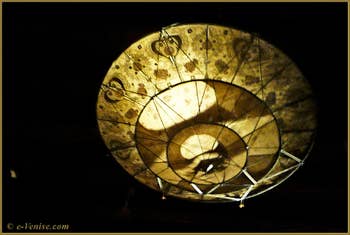
Silk Lamp Fortuny So much so that by 1912, Mariano Fortuny was opening shops in Paris (rue Marignan) and London (Old Bond Street).
In May 1914, Mariano Fortuny enjoyed further success in the United States when he exhibited his fabrics at the Caroll Gallery in New York.
Unfortunately, this fine momentum was interrupted by the First World War: no more orders, no more markets, a reduction in staff and the dissolution of the company on 15 February 1916.
Mariano would henceforth take it on in his own name as a sole proprietorship, whose articles of association speak of manual silk printing activities.
At the same time to this were added other reasons for unpleasantness and sadness: the forced exile of his friend the prince Hohenlohe, the Martinengo palace mortgaged because of the financial difficulties of his mother Cecilia, who had to sell part of her fine collection of antique fabrics.
And in 1917, the death of his uncle Ricardo y Madrazo who had looked after him during his childhood and adolescence in Paris.
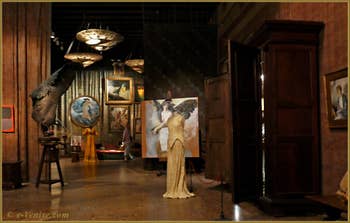
The Palazzo Mariano Fortuny Pesaro degli Orfei While waiting for better days, Mariano Fortuny and Henriette continued to work together.
Henriette took care of the pigment processing and coated the stencils for printing the fabrics herself; and Mariano travelled, always in search of inspiration, and continued his research, thinking of everything that could be used as a setting and backdrop for his clothes, making different models of indirect lighting lamps for theatre and photography, and building some very original furniture.
Appointed honorary vice-consul of Spain in Venice in 1915, and taking advantage of his country's neutrality, he was part of the committee to safeguard the city's works of art and was thus able to conserve and house a number of treasures belonging to Venice's artistic heritage.
1919: Partnership with Giancarlo Stucky at the Palazzo Grassi to open the Giudecca cotton fabric factory
. With the return to peace, the economy and business picked up again; and as early as 1919, in association with his friend Giancarlo Stucky, Mariano Fortuny founded the Société Anonyme Fortuny par actions having as its object “ mechanical printing of all kinds, with the exception of silks and velvets, as well as mechanical printing of wallpapers and photographs according to Mariano Fortuny's patents and methods. ”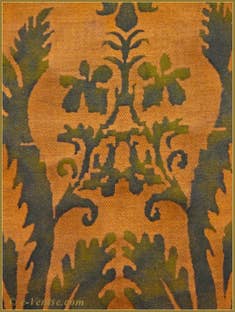
Fabric “Glicine” The Mariano Fortuny S.A. first had its headquarters at the Grassi, which was at the time the residence of Giancarlo Stucky.
It was transferred in 1921 to the Giudecca, at no. 805 Fondamenta San Biagio, where the new machines invented by Mariano Fortuny were installed :
“Later came the addition of cottons, for which I invented the particular tooling to be able to produce in greater quantities... but always maintaining the artistic side, the true aim of all my work.”
It employed fourty people at the time of its heyday, and was modernised in 1928-29.
Its mechanical printing process on white cotton was reserved for large-width yardages for upholstery fabrics.
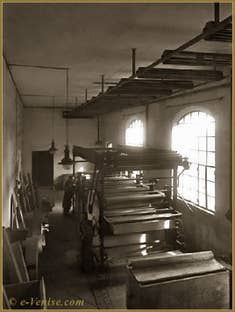
Fortuny Giudecca workshop Shorter lengths of silk and silk velvet, such as cloth for clothing, were always printed at the Palazzo Pesaro, where Henrietta continued to prepare the dyes and direct the work of the workers: seamstresses, pleaters, ironers, etc.
To sum up: the Giudecca workshop was reserved exclusively for the mechanical printing of cotton fabrics; the Palazzo Pesaro workshop specialised in the printing of silk and silk velvet fabrics, mainly used to make Fortuny garments.
1920: Opening of a new boutique on rue Pierre Charron in Paris
The old Fortuny boutique on rue Marignan closed during the war reappeared this time at 67 rue Pierre Charron, on the corner of the Champs Elysées.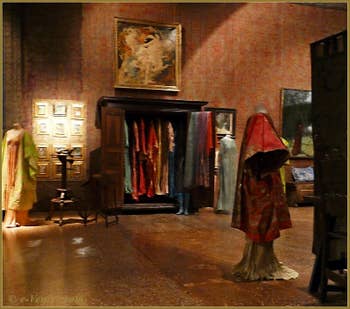
Fortuny's Palazzo In addition to dresses, tunics, coats, togas, burnous, caftans, djellabas and kimonos were sold here, all cut in the traditional styles of their countries of origin, but in the most refined Fortuny fabrics, with a wide range of patterns to match the cut of the garment.
This was a new era of success for Fortuny's Parisian clientele, thanks to printed cotton upholstery fabrics and the creation of original accessories such as “unshakeable hat stands” lamps with shades made of silk voile printed with a variety of motifs, hanging lamps inspired by Saracen shields or Chinese lanterns in the shape of polyhedrons with tassels, as well as oriental-style lamps.
Mariano Fortuny Artist and Decorator of international renown, appointed Honorary Consul of Spain and Curator of the Biennale in Venice
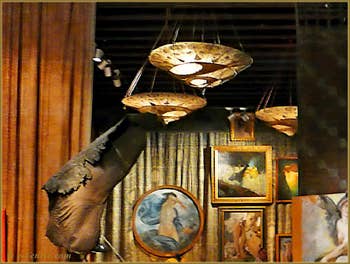
Silk lamps and paintings Mariano Fortuny Mariano Fortuny showed his talents as an interior designer by decorating the villas of celebrities such as the actress Dina Galli in Rome, of Consuelo Vanderbilt, of the princesse de Noailles, among others.
In Venice, he decorated the games room of the hotel Excelsior, as well as the church of the Redentore on Giudecca, with his fabrics.
Same goes for Naples, for the Titian room at the National Museum.
He was also responsible for fitting out the lounges on the liner Italia.
In 1922, at the Venice Biennale, he was commissioned to decorate the rooms of the Spanish pavilion, where at the same time he presented some of his works.
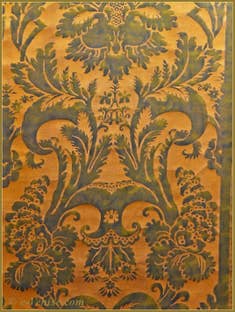
Fabric Fortuny “Glicine” And he also received the office of Commissioner of the Biennale, which he held until his death.
He was also working on a project for Parsifal, to be performed on 7 January the following year at La Scala di Milano, in collaboration with the S.A. Leonardo da Vinci commissioned to build a folding dome.
In contrast to the rest of Europe, Fortuny domes did not yet equip Italian theatres, so the one in Milan appeared to be a novelty.
In 1924, again at the biennale, he exhibited three paintings, including the portrait of Domenico Rupolo.
In December, the King of Spain appointed him Honorary Consul in Venice.
In 1925, Mariano Fortuny supplied the silk velvet fabrics for the costumes, and the printed fabrics for the stage set of “Saint Joan” by Bernard Shaw, which was to be performed at the Goldoni Theatre in Venice.
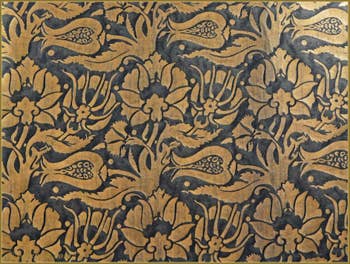
Fabric Mariano Fortuny In Paris, he was awarded a grand prize diploma at the Arts Déco exhibition, where he had once again exhibited his fabrics.
These were happy years full of success and achievement.
He was on the organising committee of the Venice Biennale of 1926; and in May 1927 at the International Exhibition of Modern Engraving in Florence, he presented three aquatints alongside a retrospective exhibition of his father's work in the Spanish Pavilion room.
And Mariano Fortuny had also become famous among literature lovers thanks to the publication by Gallimard of “La Prisonnière” and “Albertine disparue”, by Marcel Proust.
In 1929, Fortuny clothes were sold in a shop in New York, also to be worn by heroines of 1930s American literature.
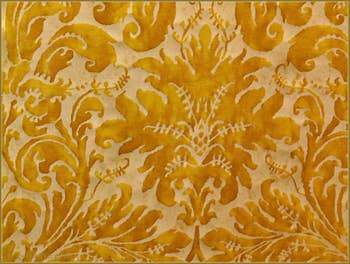
Fabric “Lucrezia”
Mariano Fortuny and the “Carro di Tespi”, a travelling theatre designed to spread dramatic art throughout Italy
In April 1929, the Leonardo da Vinci Company was commissioned to build the “Carro di Tespi” or “Char de Tespi” , based on the idea of the stage director of the Scala de Milan to create travelling theatres designed to spread operatic and dramatic culture throughout Italy, and particularly in rural areas.And this with the support of the Fascist regime, which saw it as an excellent means of propaganda for the Italian people.
The inauguration took place in July, in Rome in the presence of Mussolini and dignitaries of the regime.
Their folding domes, lightweight and easily transportable, offered all the advantages needed to realise this dream of transporting a theatre with its troupe and all its equipment in a few coaches.
They were inexpensive and technically and scenographically powerful, and their realistic effects captivated enthusiastic spectators.

Dress “Delphos”
“It seems to us that nothing has been neglected to entertain the people.
The educational aim of the company desired by the Chairman of the Works Council was pursued not only in this first choice of repertoire, but also in the stage tableaux offered to the spectators' gaze.
You only have to visit Senago to see the amazement and enthusiasm of the curious and admiring public who gather in the evening in the courtyard where the rehearsals take place.
When the curtain rises, it's an “Oh!” astonishment. Orestes' scene is grandiose and evocative.
The Fortuny dome fulfils its contract perfectly, showing a parade of changing clouds and the marvel of its tonal changes; gusty night, clear dawn, stormy evening, as seen in the greatest Operas.
And what can be said of the effect on rural populations of the vision of the wood, in the first act of The Falconer, with its romantic cypress trees and, even more romantic, its small, undulating, sparkling lake surrounded by thick leafy bushes?
Folding dome Senago audiences applaud every time they see it, and widen their eyes at what technology has brought to scenic realism in recent years.
But Gioacchino Forzano has prepared other surprises using other technical means.
The cries and tumult of the crowd in Orestes are reproduced by a gramophone equipped with loudspeakers, from which solemn songs are sung between each scene of the tragedy.
Wouldn't the ingenuous spectator in some remote village cautiously walk behind the hut where the stage is located to see the singers?”
Corriere della Sera of 20 June 1929
In Spain, Mariano Fortuny also exhibited his fabrics and lamps at the International Fair of Barcelona.
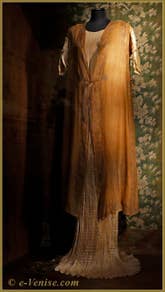
Delphos dress Plans to create a large open-air theatre in Catalonia, and to install a dome with the indirect lighting system at the Royal Theatre of Madrid, resumed and abandoned several times, never came to fruition due to the political events of the time.
After the Twenty-Nine Crisis, with financial help from Elsie Mac Neill, the wife of the concessionaire for the exclusive manufacture of Fortuny Fabrics in the U.S.A., Mariano Fortuny was able to resume his fabric production.
While admiring the masterpieces of the past, Mariano Fortuny did not neglect the new techniques of his time, such as electricity and photography, all out of a concern for aesthetic perfection.
The beauty of a work demanded the greatest attention and care in its conception and execution, and each element had to be of the highest quality and in perfect harmony with the whole, in accordance with his ideal inherited from the Wagnerians.
Mariano Fortuny photographer: 12,000 negatives and 10,000 developed photos
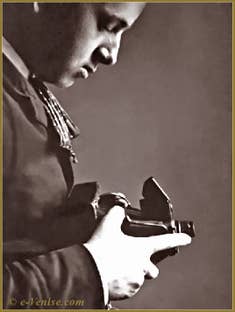
Fortuny Self-Portrait Mariano Fortuny was also a keen photographer.
He was quick to exploit this technique for his work as a stylist and set designer, photographing his models, alone or in groups, to experiment with staging and aesthetic effects.
He had built up a considerable photographic heritage.
In 1976, around 12,000 negatives (between glass plates and film) resurfaced when the management of the Fortuny Museum and the Documentation Centre began systematic research and classification of the archive holdings.
Mariano Fortuny and the many uses of photography
Mariano Fortuny began photography as a dilettante around 1888, when he was still living with his mother in Paris, at a time when France was at the forefront of photographic science and techniques.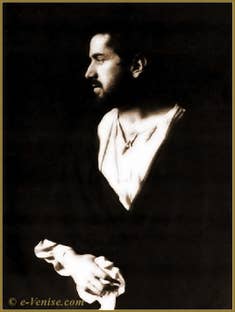
Fortuny Self-Portrait In September 1886, the “Journal Illustré” published an interview with a scientist photographed by Nadar.
Books illustrated with photographs began to be printed, and cinema took off in 1895 with the Lumière brothers.
For the sake of perfection and realism, Mariano Fortuny was always attentive to the quality of the results, constantly trying to find the best way to achieve it.
He therefore took a keen interest in optics and photographic technique, in order to make the best use of this new art form.
With his No. 4 panoramic camera from Kodak bought in Paris, he had carried out his first, somewhat “scholastic” attempts, with the reportage of a motor race and views of the Paris suburbs.
His views of Venice from 1908, no doubt in preparation for theatrical scenography, are already much more elaborate in their search for perspective and contrast.

Pont del Piovan 1907 And the 120° view offered the advantage of a dynamic view of the lagoon and the city.
In Venice, Mariano Fortuny used photography to observe and study the everyday reality of Venice, far from the prestigious itineraries visited by the wealthy tourists of the time.
Photos of Venetians of all ages in the Calli, women working in front of their houses, bridges, canals and charming little corners, which could be used as models for paintings.
There were also valuable photographers in Venice, such as Carlo Naja who published “Calli e canali di Venezia” in 1890, and Giuseppe Primoli who photographed la Duse in a gondola, and in her flat; but it is not known whether Mariano Fortuny had any contact with them.
In fact, he preferred enclosed spaces, such as the privacy of his palace.
Mariano Fortuny and his photographs of art for art's sake
Photography has enabled him to catalogue the patterns of antique fabrics in his collection, as well as traditional fabric motifs, or patterns from engravings from all over the world and from all eras, with the intention of using them as inspiration for his printed fabrics.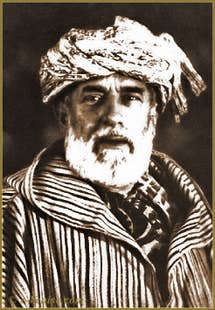
Fortuny Self-Portrait He could easily enlarge a pattern detail to repeat and print it in parallel series on fabric, while combining them with patterns of different origins.
To photograph the fabric decorations he wanted to reproduce, he particularly used large formats of 50 cm x 60 cm.
Despite the cumbersome and slow operation of the cameras of the time, Mariano Fortuny did not hesitate to use different formats (13 x 18), (18 x 24), (24 x 30) in approaching his subjects without worrying about rigorously applying the very conventional methods of professional photography. On the contrary, he was always looking for different angles, perspectives and contrasts!
Mariano, the painter who captured and composed an image, was also a theatre-lover who, while casting an affectionate eye over his friends, also composed real scenes by striking a series of poses, often humorous ones.
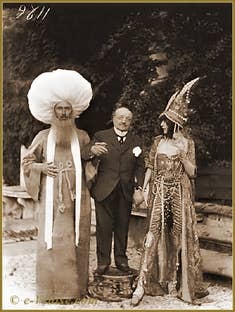
Ca' Venier dei Leoni Perhaps they were having fun parodying common scenes from the (silent) cinema of the time, but it was also reminiscent of a theatre scene where gestures and poses have great expressive, and aesthetic, value.
And his souvenir photos of parties, for example this one of a party at the Ca' Venier dei Leoni where we see the painter Giovanni Boldini perched on a pedestal, to be at the height of a man dressed as a mameluk and the Marquise of Casati who flank him by giving him their hand ; Here again, the staging and the attitudes of the characters are reminiscent of the theatre; one thinks of actors taking their bows to the audience at the end of a performance. Like many painters, Mariano Fortuny sometimes took photos of his models to paint his pictures.
In 1899, for example, he took photographic portraits of the princess Hohenlohe, seen from three-quarter back spreading “special table butter”, in order to later produce a poster advertising a brand of butter. He also painted portraits of his mother and his wife Henriette.
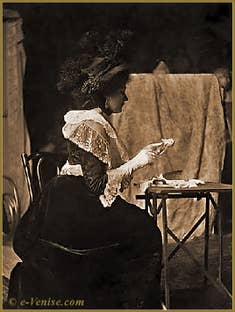
Zina Princess of Hohenlohe Mariano Fortuny made his self-portraits and portraits with a “Gilles Frères” camera with 18 cm x 24 cm plates.
He would set up his heavy wooden tripod facing the subject, which he would often analyse during an approach sequence, using the dolly technique in a pleasant, prolonged confrontation with the model in the form of a friendly dialogue, followed through the frosted glass before being captured by the sensitive plate.
His images were never definitive or finished; for this painter they were trials, sketches suggesting later details for the pose of the subject (standing, sitting, in profile, looking down or up, arms relaxed or raised, hands crossed, etc.) and against changing backgrounds (drapery, the angle of a room), always with the intention of changing the context to better perceive the aesthetic effects on the image.
The Nude Photos - Women photographed by Mariano Fortuny
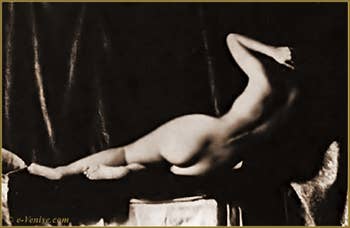
Fortuny, nude photo His photos of interiors and on the terrace of the Palazzo Martinengo also show us natural scenes, and portraits done in the fashion of the time.
Women held an important place in the life of Mariano Fortuny the stylist, who photographed his mother, his sister Maria Luisa, his wife Henriette, his friends from the Italian and international aristocracy, and female workers, some of whom were his employees.
In contrast to painting, which required long poses, photography liberated artistic creativity at the same time as it liberated the model by capturing the spontaneity and freshness of the present moment.
Such as the series of portraits of his Roman friend Giorgia Clementi, taken at the Palazzo Martinengo, which at the same time show a genuine work of aesthetic research carried out with great sensitivity.
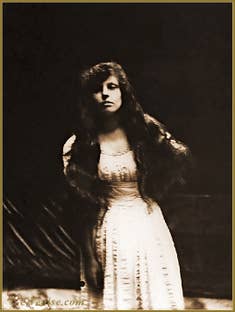
Giorgia Clementi And, of course, the many photos of his wife Henriette in Paris, travelling, or working in the studio at the Palazzo Pesaro-Orfei; not to mention those superb portraits of her wearing Fortuny clothes, with her hair done up and dressed in the ancient Greek fashion, or seen from the back showing off her beautiful hair, neck and shoulders, or with the contours of her neck, face and a few strands of hair, highlighted by a line of light against a very dark background.
And let's not forget some very nice nude photos, including the one of the stunning young woman reclining, face turned towards the lens, who is laughing as naturally as can be.
With a simple click, photography allowed him to capture, and then better understand, a gesture or attitude in successive shots in which the model raises an arm, moves a leg, lies down, bows, turns, as in the series of nudes photographed around 1920.
Mariano also used photography as a rapid means of controlling a gesture, a light, by recomposing in vivo the position of a character in a painting, such as the famous “Venus in the Mirror” by Diego Velázquez.
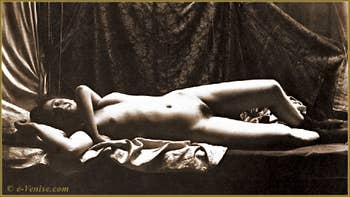
Laughing Nude by Mariano Fortuny
Mariano Fortuny fashion photographer
Curious and attentive to everything that new developments in this rapidly evolving technique could bring him, Mariano Fortuny became interested in the autochrome reproduction process of the Frères Lumière marketed in June 1907.And produced a series of photos of models wrapped in the capes and coats of his production, veritable “tableaux-photos” of fashion that gave an idea of the magnificence of his silk velvets.
The same goes for his photos of Othello, performed in the courtyard of the Doge's Palace in 1936, which show us the richness of his stage costumes.
He sometimes placed mirrors so that we could see the hidden side of the model presented.

Mariano Fortuny, nude photo The photos of the models dressed in his “delphos” dresses or draped in his “knossos” shawls strike the best pose, or sketch the gestures that show them off to best advantage.
Everything was carefully studied to avoid any lapse in taste, and to offer the most beautiful image of the woman.
His photographs of the various rooms in his palace-studio, where his paintings can be seen among the antique furniture, his dresses on dressmaker's mannequins, his printed silk lamps, his fabrics printed on the walls, furniture of his own invention such as his work tables topped with an articulated lamp, gave an idea of the prolixity of his production and his qualities as an interior decorator.
A whole universe, absolutely unique in its kind, that revealed so well the eclectic character of its owner who reproduced, in his own way, the “cabinet of curiosities” of his father's house in Rome.
1931: Mariano Fortuny invents a new type of photo paper
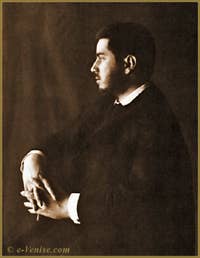
Self-portrait Mariano Fortuny knew that to achieve good results in contrast and image sharpness, the quality of the photo support was as important as that of the optics:
“There was no paper for printing that was suitable for art photography, for photographing paintings, statues, monuments, landscapes, or taking portraits.
[...] and a solution was sought to this problem, which is of great interest to those who use photography as a means of practising their profession.
Now we can say that this problem has been solved perfectly [...] the results are magnificent.”
Fortuny
And as he had done for all his inventions for lighting, and fabric printing, he filed in Paris a patent for a carbon pigment photo paper of his own invention in March 1931.
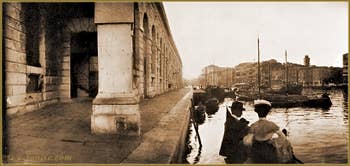
Punta della Dogana Mariano Fortuny' s photographic collection is also a collection of the various types of photographic paper in existence from its beginnings to the mid-twentieth century.
In addition to the 12,000 negatives already mentioned, we must add the 10,000 photos still preserved in his library, almost all of them in albums bound with his own fabrics.
Like all photographers, Mariano did not fail to compile souvenir albums of his travels (photos of monuments and works of art, but also souvenir portraits) in Italy, in Spain and Morocco in 1925, in Greece in 1936, and in Egypt as far as Sudan in 1938.
Mariano Fortuny, the artist and methodical perfectionist, classified his photos by themes entitled: weapons, skies, vases, nudes, landscapes, and others.
Mariano, the demiurge, gathered his clichés-fragments of reality, to represent them as aesthetic objects and subjects for reflection.
Same goes for the photos of paintings and architecture, classified and presented according to their styles, from the origins to the twentieth century.
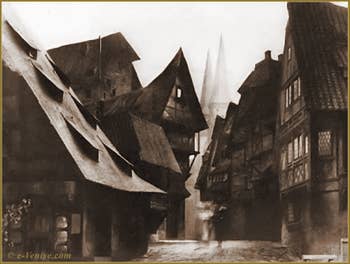
Photo of The Master Singers And his photos of works of art were not limited to simply taking a souvenir image of the whole; certain details, taken from different perspectives, reveal above all a work of analysis.
They were sometimes accompanied by critical comments.
Projections of photographs by Mariano Fortuny as backdrops on theatre and opera stages
While preparing the models for the staging of “Maîtres Chanteurs” by Wagner, performed on 27 December 1931 at the Royal Theatre in Rome, Mariano Fortuny had gone to the mountains to photograph a beautiful thunderstorm in order to reproduce it on stage.And his photographs of a drawing of a scene from Les Maîtres Chanteurs, then of the model, then of the final scene, give us at the same time an example of Mariano Fortuny's stage design work.
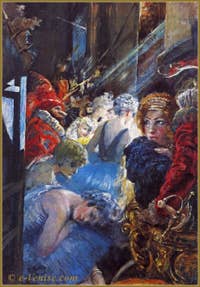
Backstage at La Scala, Milan In 1933, he was taking photographs of the town of Grenade for the production of the sets for “La Vie Brève” by the Spanish Manuel De Falla, to be projected at the Scala de Milan.
He also photographed his models of domes, and his theatre models made and lit in various ways, in order to study their effects for the development of the best lighting, but also to keep a record of his work and constitute a documentation.
All these elements clearly demonstrate the artistic and instrumental approach to photography of this eclectic perfectionist, who was fascinated by all the techniques likely to open up new possibilities in the field of art.
For Mariano Fortuny the aesthete was a rational man who studied and analysed everything methodically, including photography.

Nude study Along with scientific journals on chemistry and anatomy, he owned Muybridge's works such as “Animals in motion” and “The human figure in motion” ; and, of course, books with the female nude as their subject, such as “Images of a woman” by Jules Romains, “ Nudes” by Laryew, and “The Nude” by Drtikol.
Mariano Fortuny also did not fail to recall the memory of his father by photographing his drawings, sketches, engravings, sculptures and paintings.
They were published in 1933 in a richly bound edition with Fortuny fabrics, by Maylender Editions.
And in August 1932, he had photographed his mother Cécilia y Madrazo on her deathbed.
Mariano Fortuny, the Thirties: European success of indirect light diffusers - Exhibitions and production of theatre sets and costumes

Fortuny Autorportrait At the Royal Academy in London, Mariano Fortuny's patented indirect light diffusers illuminating the Exposition d'Art Français attracted the keenest interest from museum directors in Amsterdam, Brussels, Dublin and London, especially the National Gallery, who immediately wanted to meet him.
in Venice, he was commissioned to look after the lighting of paintings by the Tintoretto at /museums_venice/san-rocco/scuola-grande-san-rocco-venice.html, and from Carpaccio to the Scuola of the Dalmatians (or Scuola San Giorgio dei Schiavoni).
The same goes for the Titian's Assumption of the Virgin in the Church of the Frari.
He thus had the pleasure of illuminating the canvases of the masters he admired, and who had inspired him.
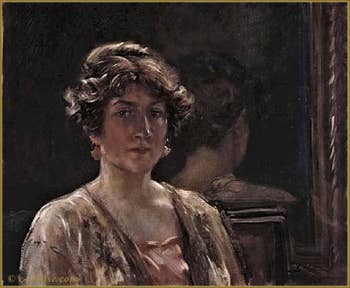
Henriette Fortuny And he marketed his tempere pittoriche, tempera colours hitherto known only to him, under the name “Tempera Fortuny”.
A publication by Jean Piot gave the technical characteristics, and the various possible uses.
In 1933, Kiki Palmer's theatre company asked him to supply the costume fabrics, and to make the costume for Othello by Shakespeare, performed in the courtyard of the Doge's Palace in August 1933.
As well as working on the sets for “La vie brève” by Manuel De Falla, performed at the Scala de Milan in January 1934.
In March 1934, he exhibited some thirty paintings, oils, watercolours and tempera at the Gallerie Hector Brame in Paris.
At the 19th Venice Biennale, he exhibited three works, including a portrait of his mother on her deathbed.
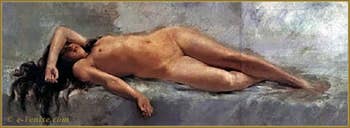
Extended nude Renouncing to represent Spain, he returned his title of vice-consul.
At the 20th Biennale, he presented another ten paintings.
He had also exhibited fabrics, paintings and other technical creations for the theatre at the Dédale Gallery in Milan.
But the autarkic economic system imposed by Mussolini in Italy soon presented him with problems sourcing raw materials in the mid-1930s.
In 1935, the shares of S.A. Fortuny suffered a devaluation as a result of losses caused by difficulties in export sales, and Mariano Fortuny could no longer receive his cottons from Manchester, nor his pigments imported from the colonies of countries that were enemies of the Italian fascist regime.
And Italy's entry into the war meant the loss of French and English credits.
Here again, the financial help of Elsie McNeil was providential.
Mariano still had to sell the album of drawings his uncle Frederico had given him.
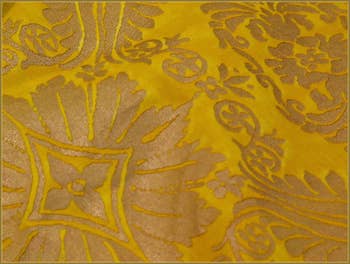
Fortuny fabric Added to this was the death of his sister Maria-Luisa.
To forget all these misfortunes for a while, Mariano and Henriette went on a trip to Greece in 1936.
In May 1937, Mariano Fortuny supplied the fabrics needed to make some eight hundred costumes for extras for a party commemorating the victory of the Maison de Savoie, given in honour of the prince of Naples at the castle of the Sforza, in Milan.
This was his last major achievement as a costume designer, in the same year that he had been responsible for lighting the works of Carpaccio and the Tintoretto, in Venice.
Having already sold 1938 the Palazzo Martinengo, inherited following the death of his sister, Mariano and Henriette set off to discover monuments and artistic treasures across Egypt, as far as Sudan.
In addition to the many souvenir photos, Mariano had painted small pictures collected under the title “vues d'Égypte”, which he exhibited at the 21st Venice Biennale.
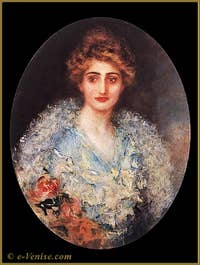
Portrait of a woman Once again appointed vice-consul of Spain in Venice in 1939, he exhibited paintings again at the Biennales of 1940 and 1942.
This was also the time when S.A. Fortuny was put into liquidation.
In 1944, Mariano Fortuny offered his sets representing Venice for a play by Goldoni performed at la Fenice.
They were reused in 1958, because they had captured the atmosphere of the city.
Mariano had initially wanted to offer his palace to Spain, to which he had remained attached.
But the latter refused the inheritance for financial reasons.
In September 1948, he wrote his will as follows:
“I leave all my property to my wife, everything I have inherited, acquired or produced, movable and immovable, everything without exception.”
Gravely ill, he died at his home in Venice on 2 May 1949.
He was buried next to his father in the cemetery of Verano, in Rome.
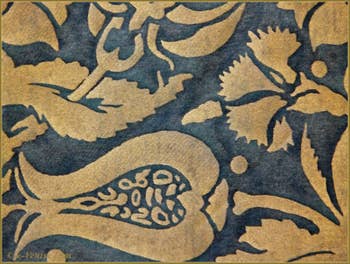
Detail of Fortuny fabric At the Biennale of 1950, a retrospective exhibition of Mariano Fortuny's works was shown in the Spanish pavilion along with those of his father, as well as those of the painters in the Madrazo family.
The company became the property of Henriette, who stopped production, limiting herself to the “sale of artistically printed”silk fabrics in stock in the warehouses.
She had set up the company “Tessuti Artistici Fortuny”, registered in April 1951 with the Venice Chamber of Commerce, which ceased trading on her death in 1965.
And the city of Venice received the palais Pesaro Orfei as an inheritance, which thus became the musée Fortuny.
But the Giudecca cotton fabric printing company for interior decoration continues to produce its beautiful fabrics to this day, still using printing machines designed by Mariano Fortuny, the workshop and shop are on the island of Giudecca in Venice.
Orson Welles and Mariano Fortuny
“1949: Orson Welles is about to embark on the interminable and costly filming of Othello, where he himself will play the character of the More of Venice.
In search of sumptuous and luxurious costumes worthy of his production, he visited Mariano Fortuny, who was secluded in his palazzo Pesaro degli Orfei, set back from the Grand Canal at the corner of the modest and silent Campo San Benedetto.
Silk lamps Fortuny At first, the relationship between the unbridled and enthusiastic filmmaker and the famous, tired and aged couturier did not go down well; in fact, he died a few months later.
Fortunately, Orson Welles's inexhaustible eloquence, as he excitedly explained his search for an Othello costume, managed to shake Fortuny out of his lethargic melancholy.
He disappears into a room and returns with an armful of costumes, from which stands out a grey-green brocade jacket, fully lined with grey fur spotted with white.
Welles tried it on in front of a mirror, contemplating himself as if descended from a Carpaccio painting: it was exactly what he was looking for.
The fur, in particular, seemed completely Renaissance to him. When he asks where it comes from, Fortuny suddenly wakes up.
These are Australian moles, which feed on the corpses of their fellow creatures; cannibalistic moles.
And all of a sudden he's all happy, declaring that he thinks it's great that a farm has solved the feeding problem at no cost.
What brutal and cruel glee!
The ferocious underside of the magnificent decor, the barbaric lining of the brocade.
Fabric “de Medici” Indeed, we can think of no finery more in keeping with the tragic fate of Othello killing Desdemona out of jealousy than this cannibalistic fur.
More in keeping, too, with Venice, where the most sumptuous brocades conceal the most ruthless settling of scores against all those suspected, rightly or wrongly, of threatening the institutions of the Republic, doge, patrician or private individual, ruthlessly eliminated by iron, poison or drowning.”
Alain Busine - “A loving and learned dictionary of the colours of Venice” Published by Zulma
We couldn't imagine a finer meeting between two great reformers of stage direction.
Orson Welles had shown his talents in this area with Citizen Kane in 1941, revolutionising film technique (editing, sets, camera movements).
And, although he was indifferent to the artistic innovations of his century, we might also wonder why Mariano Fortuny was not interested in cinema, both technically and artistically, as he had been in photography, and in directing for the theatre and opera....
The Mariano Fortuny Museum in Venice
The Palazzo dei Orfei in Venice in which Mariano Fortuny lived, painted and created for most of his life and until his death can be visited in Venice, this palace has been transformed into a museum in which you can admire his fabrics and dresses, his paintings and his studio.The Mariano Fortuny Museum in Venice ➤
Fortuny Museum Fortuny | Martinengo Orfei | Theatre | Clothes Fabrics | Photography Costume
Painters Tintoretto | Titian | Canaletto | Fortuny | Albrecht Dürer |
Art Painters | Music | Literature | Video | Pictures
Back to Top of Page


